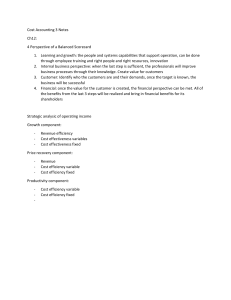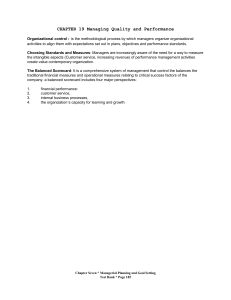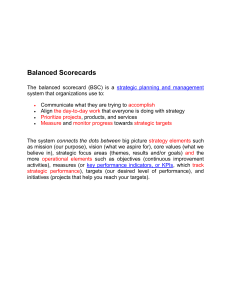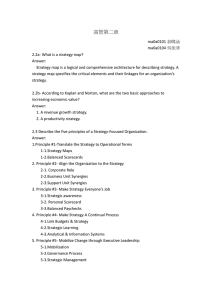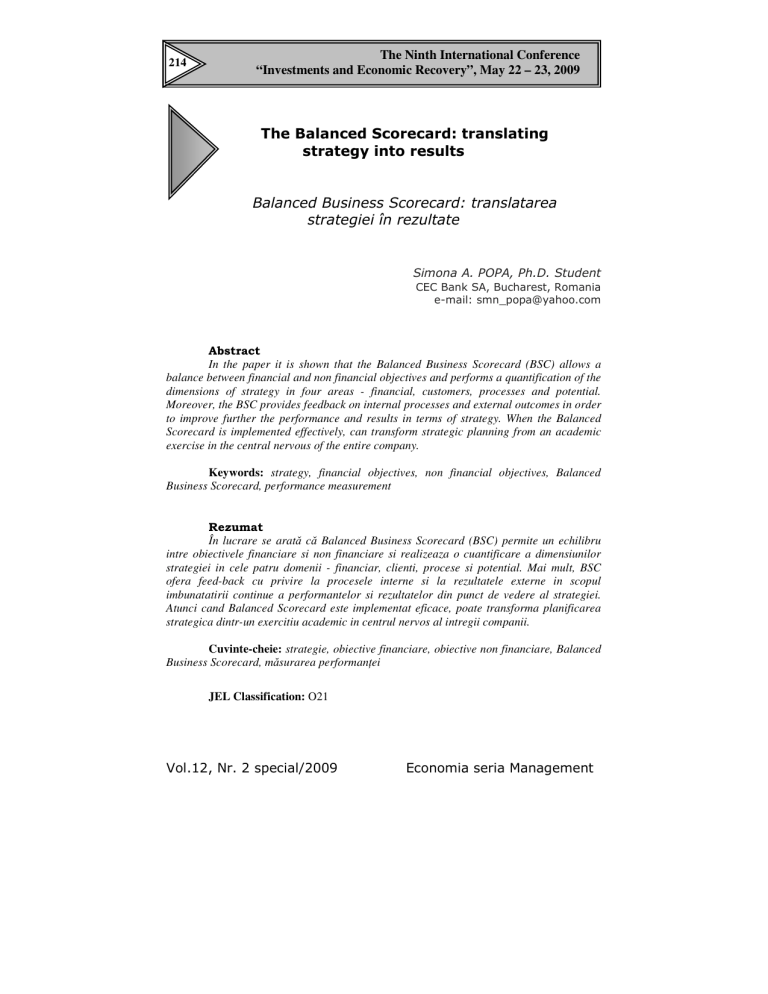
214 The Ninth International Conference “Investments and Economic Recovery”, May 22 – 23, 2009 ! " # $ %& In the paper it is shown that the Balanced Business Scorecard (BSC) allows a balance between financial and non financial objectives and performs a quantification of the dimensions of strategy in four areas - financial, customers, processes and potential. Moreover, the BSC provides feedback on internal processes and external outcomes in order to improve further the performance and results in terms of strategy. When the Balanced Scorecard is implemented effectively, can transform strategic planning from an academic exercise in the central nervous of the entire company. Keywords: strategy, financial objectives, non financial objectives, Balanced Business Scorecard, performance measurement În lucrare se arat c Balanced Business Scorecard (BSC) permite un echilibru intre obiectivele financiare si non financiare si realizeaza o cuantificare a dimensiunilor strategiei in cele patru domenii - financiar, clienti, procese si potential. Mai mult, BSC ofera feed-back cu privire la procesele interne si la rezultatele externe in scopul imbunatatirii continue a performantelor si rezultatelor din punct de vedere al strategiei. Atunci cand Balanced Scorecard este implementat eficace, poate transforma planificarea strategica dintr-un exercitiu academic in centrul nervos al intregii companii. Cuvinte-cheie: strategie, obiective financiare, obiective non financiare, Balanced Business Scorecard, m surarea performan ei JEL Classification: O21 The Ninth International Conference “Investments and Economic Recovery”, May 22 – 23, 2009 215 sustained competitive success can be achieved today only if a company is flexible, adapting quickly to the market. This involves organizational structures based on processes that reflect if this is necessary dynamics and future market position held. Most companies try to adapt in terms of flexibility of all changes on the market to maintain market position. In today’s world of rapid change and unforgiving competition, a myriad of leadership challenges face the business executive: ♦ The increasing need for speed ♦ The need for alignment across the organization ♦ The need to focus on action and results ♦ The need for better ways to measure the health and success of the organization ♦ The need to attract and retain the right staff in an increasingly competitive environment Strategy is of critical importance in today's business environment of rapid change and unforgiving competition. Many organizations devote extensive resources to developing a winning strategy, then wonder why they aren't winning. Organizations fail to realize the benefits of a good strategy for a variety of reasons: ♦ Failure to implement the strategy - They develop an excellent plan, then it sits on the shelf. ♦ Failure to communicate the strategy - Senior management understands the strategy, but the line personnel who interact with customers on a daily basis have no idea what their role is in implementing the strategy and contributing to corporate goals. ♦ Failure to translate the strategy into actionable initiatives - Managers treat strategy development as an annoying interruption that takes time away from doing business. They fail to devote the time and effort necessary to translate the high level strategy into tactical initiatives that drive change on an operational level. The balanced scorecard provides a framework for translating strategy into action into results. Its benefits include the following: ♦ Alignment - The balanced scorecard provides a mechanism for aligning the various activities, processes, and groups throughout the organization with the strategic goals and objectives. ♦ Communication - The balanced scorecard and the decisions and actions that it drives become a mutually reinforcing, highly visible way to communicate the strategy throughout the enterprise. ♦ Accountability - The balanced scorecard links individual performance to corporate strategy and provides a constructive mechanism for holding people accountable for results. The Ninth International Conference “Investments and Economic Recovery”, May 22 – 23, 2009 216 ♦ ♦ Individual contributions - As managers and individuals throughout the organization come to understand the strategy and how their performance contributes to success, they are able to exploit circumstances and make independent decisions that contribute to the strategy in ways never anticipated by the drafters of the strategy. Transformation - As people work together to achieve common objectives, the balanced scorecard provides leverage and becomes a multiplier. As performance is reported throughout the organization, the feedback process becomes a mechanism to transfer knowledge and to refine and modify the strategy based on facts and insights of people throughout the enterprise. Strategy development becomes an ongoing, dynamic process that can evolve readily in response to changing circumstances, new ideas etc. The balanced scorecard is a performance management framework that links strategy with day-to-day operations. It provides a holistic view of the enterprise based on the business objectives. The balanced scorecard consists of a set of performance measures that give a comprehensive view of the company based on four perspectives (Figure 1). To succeed financially, how should we appear to our shareholders? Financial Goal Internal Business Process Customer Goal Vision and Mission Measure Target Initiative To achieve our vision, how should we appear to our customers? Adapted from Kaplan and Norton Measure Target Initiative Goal Measure Target Initiative Learning and Growth Goal Measure Target Initiative To achieve our vision, how will we sustain our ability to change and improve? Figure 1. Balanced Business Scorecard To satisfy our shareholders and customers, at what business processes must we excel? The Ninth International Conference “Investments and Economic Recovery”, May 22 – 23, 2009 217 Financial perspective, including traditional financial measures such as revenue growth, return on investment or return on assets, market share, and earnings per share, ♦ Customer perspective, with measures of importance to customers such as timeliness, quality, performance, cost, and service, ♦ Internal business process perspective, with measures of the critical internal activities and processes that the organization uses to meet its customers' expectations, and ♦ Learning and growth perspective, which measures the organization's ability to adapt and innovate for the future; this could include time to market for new product development, workforce training and development, and process improvement. These perspectives provide a multi-dimensional balance between internal and external perspectives, leading versus lagging indicators, objective versus subjective measures, current versus future needs etc. Tradeoffs become explicit business decisions based on strategy. ♦ Kaplan R.S. and Norton D.P. (1992). “The Balanced Scorecard - Measures That Drive Performance”, Harvard Business Review, Vol.70, Jan-Feb Kaplan R.S. and Norton D.P. (1993). “Putting the Balanced Scorecard to Work”, Harvard Business Review, Sept-Oct Kaplan R.S. and Norton D.P. (1996). Translating Strategy into Action, HBS Press, USA Kaplan R.S. and Norton D.P. (2000). The Strategy Focused Organization, HBS Press, USA
